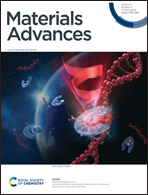PVA/guanidinium oleate transdermal patch as a pH-responsive drug delivery system for the localized and targeted delivery of anticancer drugs†
Abstract
The exponential growth in the development of biocompatible patch-type drug delivery as an alternative to traditional intravenous or subcutaneous injections is because it can be applied to patients with needle phobia and can overcome the need for highly trained personnel. Through a patch, a drug can be administered locally, ensuring relief from side effects and the regulated distribution of the drug to the site of action. Keeping in mind the relevance of mucoadhesive polymers (e.g. polyvinyl alcohol, PVA) in site-specific drug delivery, an attempt was undertaken in the current study to create a mucoadhesive patch of PVA through mixing it with a pH-responsive surface-active ionic liquid (guanidinium oleate, [Gu][Ol]). The patch was studied for its pH-responsiveness, mechanical qualities, adhesive properties, stretchability, and self-healing properties. The studied mucoadhesive patch was further used to load and deliver anticancer medication 5-fluorouracil (5-FU) through transdermal delivery at pH 7.2. The drug-release profiles of the transdermal patch revealed that up to 60% of the adsorbed medication was released in 48 hours at pH 7.2. The results demonstrate that the designed transdermal mucoadhesive patch is a potent pH-responsive vehicle for targeted and localized drug delivery.



 Please wait while we load your content...
Please wait while we load your content...